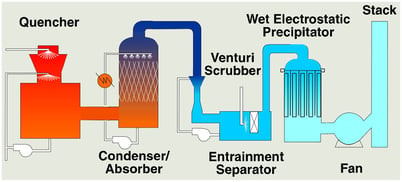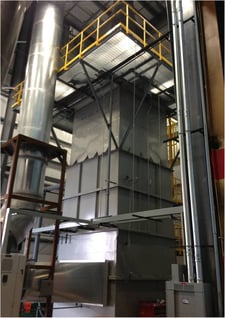Industrial facilities are increasingly called upon to consider the use of wet electrostatic precipitators (WESPs) for emissions control as regulations for PM 2.5 and specific heavy metals become more stringent. Facility and Environmental, Health, and Safety (EHS) Managers may need to become familiar with WESP technology and how they can be applied to their facilities.
WESPs date back to the 1970’s and are a tried-and-true method for removing submicron particulates, aerosols, SO3, opacity, and condensed heavy metals. They are generally robust and suitable for 24/7 continuous operations. Their use is found in steel melting furnaces, secondary lead smelters, hazardous waste combustors (HWC), medical waste and sewage sludge incinerators, wood products and pellet manufacturing, mineral wool and glass manufacturing, silicon monomer manufacturing, semiconductor manufacturing, and even industrial fryers.
 The adjacent figure illustrates WESP’s primary use. The graph shows removal efficiency on the vertical axis and particle size on the horizontal axis. The red curve shows typical WESP performance. The dotted blue curve shows typical Venturi scrubber performance. A comparison shows that a Venturi scrubber is highly effective at removing particles greater than 1 micron in size. However, performance drops off rapidly for particles below 1 micron. WESP performance is relatively immune to particle size and maintains high performance for particles below 1 micron. This capability is derived from the use of electrical forces for particle removal compared to a Venturi scrubber which uses mechanical forces. WESP’s are generally higher capital cost than Venturi scrubbers but lower operating cost. They are used in cases where performance cannot be achieved with a Venturi scrubber or other, lower cost control device.
The adjacent figure illustrates WESP’s primary use. The graph shows removal efficiency on the vertical axis and particle size on the horizontal axis. The red curve shows typical WESP performance. The dotted blue curve shows typical Venturi scrubber performance. A comparison shows that a Venturi scrubber is highly effective at removing particles greater than 1 micron in size. However, performance drops off rapidly for particles below 1 micron. WESP performance is relatively immune to particle size and maintains high performance for particles below 1 micron. This capability is derived from the use of electrical forces for particle removal compared to a Venturi scrubber which uses mechanical forces. WESP’s are generally higher capital cost than Venturi scrubbers but lower operating cost. They are used in cases where performance cannot be achieved with a Venturi scrubber or other, lower cost control device.
 WESPs are often integrated with other control technologies and used as a polishing device at the end of a process. This is shown in the adjacent illustration for a typical waste incinerator. Perhaps the most important aspect to understand about WESP technology is the relationship between performance, size, and cost. Higher performance requires more collection area, larger footprint, and more cost. This is different than other control technologies like a Venturi scrubber or packed bed scrubber. For these devices, size and cost is primarily determined by the gas flow rate while operating cost is determined by performance. Size and cost for a WESP on the other hand is determined not only by gas flow rate but also removal efficiency. It is therefore important to have a good understanding of the range of inlet particulate concentrations and outlet emission limits. Specifying performance of 90%, 95%, or 99% removal will make a substantial difference on size and cost.
WESPs are often integrated with other control technologies and used as a polishing device at the end of a process. This is shown in the adjacent illustration for a typical waste incinerator. Perhaps the most important aspect to understand about WESP technology is the relationship between performance, size, and cost. Higher performance requires more collection area, larger footprint, and more cost. This is different than other control technologies like a Venturi scrubber or packed bed scrubber. For these devices, size and cost is primarily determined by the gas flow rate while operating cost is determined by performance. Size and cost for a WESP on the other hand is determined not only by gas flow rate but also removal efficiency. It is therefore important to have a good understanding of the range of inlet particulate concentrations and outlet emission limits. Specifying performance of 90%, 95%, or 99% removal will make a substantial difference on size and cost.
WESP technologies can vary greatly between vendors which can have an impact on footprint, maintenance, and long-term performance. Some of these differences include:
- Tube geometry (square, round, or hexagonal)

- Tube size
- Tube length
- Operating voltage
- Electrode construction
- Electrode alignment mechanism
- Bottom support grid requirement
- Gas distribution mechanism
It’s recommended that facilities evaluating WESP technologies dedicate time to understand differences in WESP designs and potential impacts on operations. Evaluation may also include how the WESP is integrated with other upstream equipment needed to meet multipollutant emissions criteria.
WESP technology is a substantial investment for any facility but may be the best available control technology for a submicron particulate application.
Click on the link below to download WESP scrubber literature.


